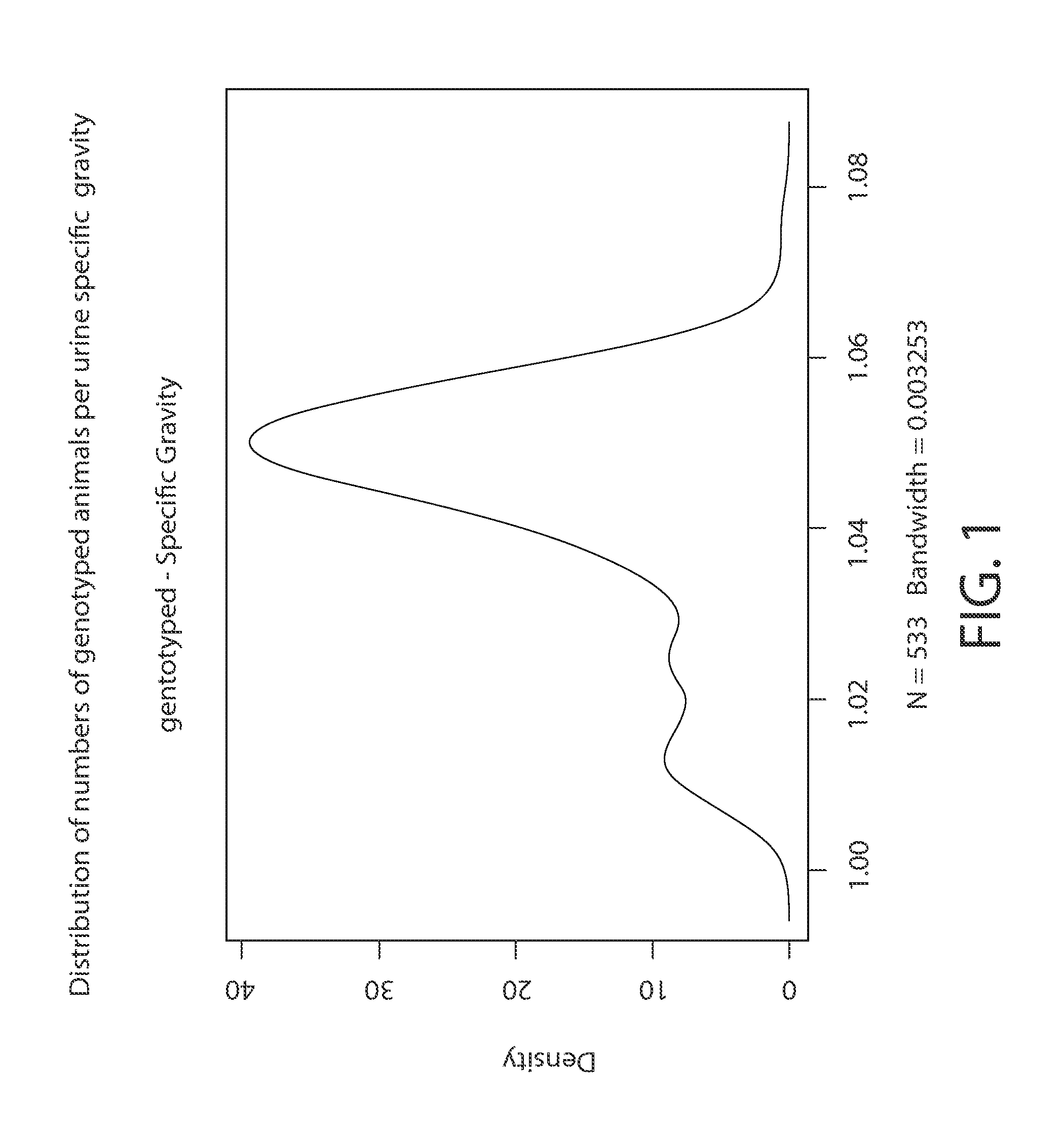Improving the Level of Hydration in a Cat
- Summary
- Abstract
- Description
- Claims
- Application Information
AI Technical Summary
Benefits of technology
Problems solved by technology
Method used
Image
Examples
example 7
Genetic Studies
[0070]Urine specific gravity values are determined for 533 cats that have been genotyped using the Illumina Feline SNP60 array (full description table 1).
TABLE 1Description of the Genotyping array used for the whole genomeassociation study for feline urine specific gravityIllumina, Inc.DescriptorFelineSNP60_11490519_B.csvFile NameAssayInfinium HD UltraFormatDateJan. 25, 2011ManufacturedLoci Count62897
[0071]The distribution of animals per given urine specific gravity is plotted in FIG. 1. Taking the deviation from the normal distribution a quantative trait locus QTL analysis is performed. A Manhattan Plot is constructed, each single nucleotide polymorph (“SNP”) genotyped is plotted against the significance of its correlation with the phenotype of urine specific gravity. Only one peak of SNPs is observed significantly above a false discovery cutoff of 10 (−6) indicating that this genetic locus is involved in determining the urine specific gravity. These SNPs are located...
example 2
A Study in Mature Cats Using Differential Ratios of AA to EPA
[0073]In Diet 1 the AA ratio to EPA is 3 to 1, and in Diet 2 the ratio of AA to EPA is 0.5 to 1. Diet 1 contains 20.84% total fat, 0.10% AA (0.48% total fat) and 0.03% EPA (0.14% total fat). The test foods contained approximately 31.5% protein, The high AA ratio fat concentration was 20.8% while the low AA to EPA ratio was 15.7% fat. The ratio of omega 6 fatty acids to ornega-3 fatty acids in Diet 1 is 14.4. The animals are maintained on the two diets (27 cats fed the high AA to EPA ratio and 54 cats fed the low AA to EPA ratio). Urine is collected and analyzed for urine specific gravity at day 0 and day 180, data presented in Table 5 (g / ml):
TABLE 5Urine Specific Gravity Change in Senior CatsDay 0Day 180High1.061.054Low1.061.061
[0074]The group of cats on the high AA ratio diet (High) exhibits a significantly reduced urine specific gravity after 180 days. The group of cats on the low AA ratio diet (Low) exhibit no change in...
example 3
A Feeding Study in Kittens with Differential Ratios of AA to EPA
[0076]In the control diet, the ratio of AA to EPA is 0.4 to 1 in Diet A (the increased AA / EPA diet) the ratio of AA to EPA is >8 to 1, and in Diet B (the further increased AA / EPA diet) the ratio of AA to EPA is >16 to 1. The control diet contains 15.06% total fat, 0.09% AA (0.6% total fat) and 0.23% EPA (1.53% total fat); Diet A contains 14.67% total fat, 0.08% AA (0.55% total fat) and <0.01% EPA (<0.01% total fat); and Diet B contained 16,01% total fat, 0.16% AA (1% total fat) and <0.01% EPA (<0.01% total fat). The ratio of omega-6 fatty acids to omega-3 fatty acids in Diet A is 18.1 and in Diet B is 17.5. The animals are maintained on the three diets. Urine is collected and analyzed for urine specific gravity at day 0, day 28 and day 56. The results are as set forth in Table 3 (g / ml):
TABLE 7Urine Specific Gravity Change in KittensDay 0Day 28Day 56Control1.0571.0571.057Diet A1.0571.0541.053Diet B1.0571.0541.054
[0077]Th...
PUM
| Property | Measurement | Unit |
|---|---|---|
| Fraction | aaaaa | aaaaa |
| Time | aaaaa | aaaaa |
| Fraction | aaaaa | aaaaa |
Abstract
Description
Claims
Application Information
 Login to View More
Login to View More - R&D
- Intellectual Property
- Life Sciences
- Materials
- Tech Scout
- Unparalleled Data Quality
- Higher Quality Content
- 60% Fewer Hallucinations
Browse by: Latest US Patents, China's latest patents, Technical Efficacy Thesaurus, Application Domain, Technology Topic, Popular Technical Reports.
© 2025 PatSnap. All rights reserved.Legal|Privacy policy|Modern Slavery Act Transparency Statement|Sitemap|About US| Contact US: help@patsnap.com



